Blog Categories
Blog CategoriesSaint Patrick and Saint Brigid - Did Ireland's Two Greatest Saints Know Each other?
 |
| Statue of Saint Patrick on Hill of Slane |
Patron saint or Celtic Goddess? Saint Brigid is very much back in conversations and headlines since the new public holiday was announced in her honour. The fifth-century abbess has stepped out of the shadow of the better known Saint Patrick.
Now it's time for Saint Patrick's Day six weeks later - Ireland's other great patron saint. But did Ireland's two greatest saints know each other?
There are many theories about this, but according to some historians, Saint Brigid's friendship with Saint Patrick was well recorded in the ninth century 'Book of Armagh'.
Written over a thousand years ago, it states that: 'Between Saint Patrick and Saint Brigid, the pillars of the Irish people, there was so great a friendship of charity that they had but one heart and one mind."
 |
| Saint Brigid's Cross |
While unfortunately Brigid left no historical record of her own missionary work, Patrick wrote two letters that still survive today - one was a defence and explanation of his missionary career and the other was a criticism of a slave-owning King in Britain. The information that we have about Brigid comes from writings of saints written long after she lived.
Throughout both their stories, Saint Brigid is closely associated with Saint Patrick. It's also said by historians that she was baptised by Patrick and developed a close friendship with him. As a young girl, Brigid felt called to be a nun. Born around 453 AD and supposedly dying around the year 524 AD, she was the daughter of a slave and a chieftain. Many records were destroyed and she was effectively sadly written out of history for many decades.
Both Saint Brigid and Saint Patrick are patron saints of Ireland, but each had very different methods of converting people to Christianity from paganism during medieval times in Ireland. The main reason for the differences in their approach was due to their difference in origins. Saint Patrick’s approach was much stronger and was aimed towards people in the druid class. Saint Brigid's approach, which was gentler, was directed toward the ordinary people who continued to follow pagan rituals.
Although their approaches were different, it seems that Saint Bridget’s approach to conversion yielded greater results than Saint Patrick’s, because it was gentler in not opposing beliefs but it brought their pagan beliefs into an acceptance of this new Christianity. Famous for being the only female bishop in the Christian Church, her remarkable achievements are now recognised for what they were.
While records vary about the connections between Saint Brigid and Saint Patrick during their lifetimes, they're said to be united in the afterlife. The Annals of the Four Masters record that in AD 525 the body of Saint Brigid was interred at Dun, the same tomb that Patrick was in with 'honour and veneration'. This refers to Saint Patrick being said to be buried at Down Cathedral in Downpatrick, County Down, alongside Saint Brigid and Saint Columba, although this has never been fully proven.
